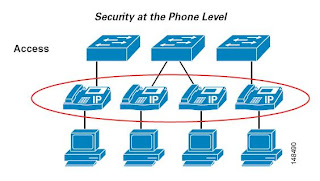A personal detailed view of a journey of acquiring IT certifications and career progression.
Wednesday, August 31, 2011
Call Processing Overview
I'm on part 2 of the Unified CM SRND guide, it's a good 400 pages long so it's going to take me a while to finish this section. The last few days I went through 40 pages or so reading up on a high-level over view regarding the best ways to deploy Call Manager 8.x along with providing scalability, resiliency, and high speed performance. This is for all three flavors of Cisco Unified Communications:
Cisco Unified Communications Manager (CUCM)
Cisco Unified Communcations Manager Business Edition (CMBE)
Cisco Unified Communications Express (CME)
Sunday, August 28, 2011
Unified CM Clustering over the WAN
I went over yet another Cisco VoIP deployment model which involves configuring a CM cluster that is spread over multiple remote sites. So there is a subscriber and maybe a backup subscriber (depending on resiliency needed) at each site that is to be involved with the CM Cluster. With that you provide either local fail over or remote fail over. Local fail over provides the most resilience sense it implies that there's a subscriber and backup subscriber at each site. Remote fail over provides more flexibility since you are failing over to another remote sites CM subscriber server essentially instead of failing over to your own local subscriber. This model only requires one subscriber as well.
I also reviewed the section that discusses virtualization of all of these different deployment models using Unified Computing System (UCS) which is just all of the Cisco VoIP products deployed on a VMware system using Fibre Channel over Ethernet (FCoE) as the media for communication between them all.
Saturday, August 27, 2011
Intercompany Media Engine Architecture
I had a quick study session this morning reading up more on a new feature to me called Cisco Intercompany Media Engine. I went over the call processing and how it uses IME compatible ASA's and Unified CM's to learn and place calls between enterprises. Along with our to fail over to PSTN in case of connectivity or latency issues. It's a pretty neat technology but I'm curious as to how many enterprises implement this solution currently.
Sunday, August 21, 2011
Multisite Distributed VoIP Deployment
I briefly went over the Multisite Distributed VoIP Deployment section in the SRND Guide. It has very similar attributes and requirements as the centralized model except it is a lot more versatile due to having a call processing cluster at each site. That eliminates the need to depend on the WAN or whatever media of inter-site connectivity for calls as much. I also began reading about the Cisco Intercompany Media Engine which seems to dynamically interconnect different enterprise organization phone numbers and create a network similar to how internet was when it was first created. Instead of just IP services, the network is used to connect Unified Communications within all the Enterprises. There's a lot more to learn about this technology and I may be off a little bit with my understanding of it at this point in time.
Saturday, August 20, 2011
VoIP Site Based Design Models
I spent sometime this morning reading through the various VoIP deployment models and how to implement high availability with each model while trying to get over this cold I currently have. So far I only went through the Campus model and the model that shows centralized call processing with multiple sites. In my current work environment we currently use the latter which is a centralized site that provides all the call processing which is then distributed to our multiple remote call centers. We're working on converting this into a more highly available solution which is a distributed model.
I plan on reading up on the other site based design guides that shows the distributed model along with a few others. I'm starting to see that there are multiple ways to provide redundancy using tools such as SRST (Survivable Remote Site Telephony), Distributed Communications Manager Express (CME), and many others.
Sunday, August 14, 2011
Finally moving back to the VoIP World
I haven't posted in a while but I finished up the TCP/IP Vol 1 book going through the subjects that I feel I needed to review before going back to VoIP. Mainly the interior routing protocols and overview regarding redistribution and basic static routing. This was all for making sure I had foundation for building on my VoIP knowledge to tackle the CCNP: Voice and maybe the CCIE: Voice. How can you sufficiently route voice over IP packets if you don't know how to route IP packets on its own?
I feel comfortable enough with IP routing to start diving deep into the Voice world and I have. It doesn't appear that the new CCNP: Voice reading material is quite done yet so I'm starting with Cisco Solution Reference Network Designs (SRND) material. These are really good free reading material providing best practices and design for all types of network solutions from security, voice, routing/switching, wireless, etc. Also moving to a new place leaves you pretty broke for a while and I know I'm going to have to drop some $$$ for additional lab equipment, books, and the 4 test to become CCNP: Voice certified. So I'm saving up money now while I scavenge the internet for free material!
I started with the Cisco 8.x CUCM SRND last week and I'm already at page 148 (1356 pages total) putting in about an hour of study a day.
Today I started on the security section for both the access layer and phone level. Talks about many basic things such as Man in the Middle Attacks, port security, disabling phone PC ports, etc. Tomorrow I'll read through material regarding Access Lists (ACLs) in a Unifed Communication environment.
Subscribe to:
Posts (Atom)







